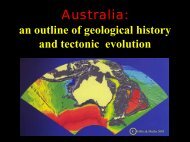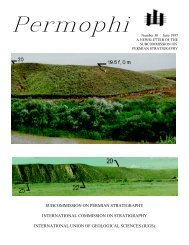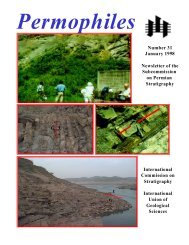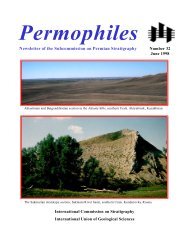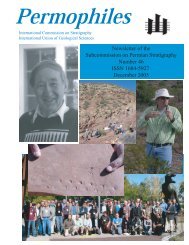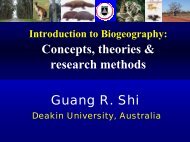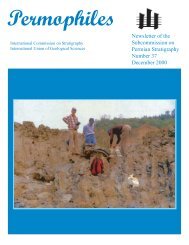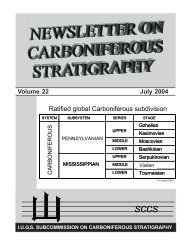Permophiles
Permophiles
Permophiles
Create successful ePaper yourself
Turn your PDF publications into a flip-book with our unique Google optimized e-Paper software.
<strong>Permophiles</strong> Issue #39 2001Type species: Hindeodus cristulus (Youngquist and Miller) 1949Pa element of type species is characterized by occurrence ofwhite matter cores in the denticles. Deepest cores are situated inthe anterior part of the element, and posterior denticles have smallwhite matter cores (Fig. 1.1). Core of anteriormost denticle is slightlyshifted toward the posterior (Figs. 1.1, 2.1). This shift is a feature atthe generic level; it occurs in all Carboniferous, Permian, and Triassicspecies.Hindeodus excavatus (Behnken) 1975In the Pa element, white matter composes denticle coresand their roots areseparated by lamellar tissue. Theroots are not deep and increased slightly toward theanterior. The anteriormost denticle demonstrates acharacteristic shift of the white matter core (Fig. 2.2).Regular microreticulation texture (MRT) dominates over theelement blade, denticles are covered by striation (MRT classificationsee in Zhuravlev, 2001).Hindeodus julfensis (Sweet) 1973The Pa element is characterized by cores of denticles composedof white matter. The cores have rather short roots slightlyincreasing toward the anterior. The white matter core of theanteriormost denticle is shifted significantly toward the posterior(Fig. 2.3).Element blade is covered by regular MRT and the anteriormostdenticle bears linear MRT grading into striations.Hindeodus minutus (Ellison) 1941Hindeodus parvus erectus Kozur 1996In the Pa element, white matter composes denticles and theirdeep roots in the blade. The roots are distributed very close toeach other and become deeper toward the anterior (Figs. 1.2, 2.6).The relation of sizes of denticle cores and their distribution aresimilar to those of Hindeodus parvus parvus.Element is covered mainly by regular MRT excluding the denticlesbearing striations.Hindeodus typicalis (Sweet) 1970In the Pa element, white matter composes denticle cores andtheir roots in the blade. The roots are separated by lamellar tissueand decrease in depth toward the posterior. The anteriormost denticlecore is shifted toward the posterior (Figs. 1.4, 2.7).The blade is covered by regular MRT grading into linear MRTand striations on the denticles.ConclusionsAll studied species of Hindeodus show a similarity in hardtissue histology and microreticulation textures. However, theHindeodus parvus group can be distinguished by the essentialdifference between depth and width of the anterior denticle coreand the depth of cores of the other denticles. The depth of coreroots of the denticles (excluding anterior ones) is rather uniformand the cores are nearly fused. These features can be observed inexamples of incomplete preservation (upper part of anteriormostdenticle is broken or all the denticles are broken). So, they can helpto distinguish the H. parvus group from other Late Permianhindeodids, but the Early Triassic Isarcicella has similar histologicalfeatures.In the Pa element, white matter composes denticles and theirroots in the blade. The roots are separated by lamellar tissue thatbecomes deeper toward the anterior (Fig. 1.3). The white mattercore of the anteriormost denticle shifted toward the posterior (Figs.1.3, 2.4), however some examples figured by H. Kozur (1978, Taf.VII,figs. 18, 20, 22) demonstrate that a wide core of white matter occupiedwhole whole denticle.The blade and upper surface of the basal cup are covered byregular MRT, denticles bear linear MRT grading into striations.Average cell imprint size (for regular MRT) is about 7 um.Hindeodus parvus parvus (Kozur and Pjatakova) 1976In the Pa element, white matter composes denticles and theirdeep roots in the blade. The deepest roots are in the anterior denticles.The anteriormost denticle has the white matter core shiftedtoward the posterior in the lower part (Fig. 2.5). This species differsfrom other Late Permian hindeodids by the essential root ofthe anteriormost denticle core (deep and wide) and it is less differentin depth from the other denticle cores. These cores are nearlyfused. Average depth of the cores is higher (in relation to theblade height) than in other hindeodids (Fig.2).The blade is covered by regular to linear MRT grading intostriations on the denticles.7AcknowledgementsThe author thanks Dr. G. V. Kotlyar for kind assistance andcollection of conodont samples. This work was supported by RFBRgrant.ReferencesKozur, H. 1978, Beitrage zur Stratigraphie des Perm. Teil 1. DieConodontenchronologie des Perm: FriebergerForschungshefte, 334, p. 85–161.Kozur, H. 1989, Significance of event in conodont evolution for thePermian and Triassic stratigraphy: Cour. Forsh.-Inst.Senckenberg, 117, p. 385-408.Yin H., Zhang K., Tong J., Yang Z., Wu Sh. 2001, The GlobalStratotype Section and Point (GSSP) of the Permian-TriassicBoundary: Episodes, 24(2), p. 102-114.Zhu X., Lin L., Zhong Y. 1997, The further study of Hindeodusparvus in P\T boundary bed in Northern Jiangxi, andrediscussion of P\T boundary: Journal of Jiangxi Normal University,21, p. 1-5.Zhuravlev, A.V. 2001, Variation in the outline and distribution ofepithelial cell imprints on the surface of polygnathacean conodontelements: Lethaia, 34(2), p. 136-142.



